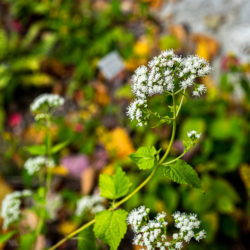Etymology
Ageratina is Latin for ‘like Ageratum,’ and altissima comes from the Latin word for tall.
Garden Uses
Prefers moist but may tolerate sandy, dry soils. Blooms with goldenrods, and lovely naturalized. Consider for cottage, native, or rain gardens or woodland edges. Self-seeds and spreads by rhizomes, so can spread rapidly under optimal conditions.
Overview
A perennial herb native to sunny, deciduous woodlands or thickets. Drought tolerant, but prefers moist, well-drained soils. Can tolerate shade better in southern latitudes. Previously classified under the genus Eupatorium, with Boneset (E. perfoliatum), which has a similar flower, but less branching, and longer, narrower leaves. White snakeroot is considered poisonous to cattle, and to humans through contaminated milk and meat; ingestion is believed to have been the cause of death for Abraham Lincoln’s mother.
Leaves and Stems
Leaves are 2 to 6 inches long, and 1 to 4 inches wide, with coarse teeth around all edges. Undersides show hairy growth along the veins. Leaves are sharply pointed, with a broader, rounded or heart-shaped base. They grow in pairs on a slender, hairless, green stalk that is up to 2-1/2 inches long. Stems are typically firm and branching, and grow 1 to 5 feet tall.
Flowers
Flat-topped clusters, 1- 2 inches across, with small, white, fuzzy flower heads composed entirely of 10 or more 5-parted disc flowers (i.e., flowers that have no petals). Protruding styles create the fuzzy appearance. Blooms late summer through frost.
Fruit/Seed
Black seeds have silken parachutes for wind dispersion.
Wildlife Associates
Attracts bees and butterflies. Tolerates deer.
Propagation
Seeds can be sown in the autumn; plant thickly, as germination is low. Alternatively, vigorous portions of mature clumps can be divided in spring or autumn.
Ethnobotanical Uses
At one time, it was thought to be a treatment for snake bite.
Garden Location
Performance Hall Garden (see garden map)
Sources
Lady Bird Johnson Wildflower Center
Plant Profile by Kate O'Dell

